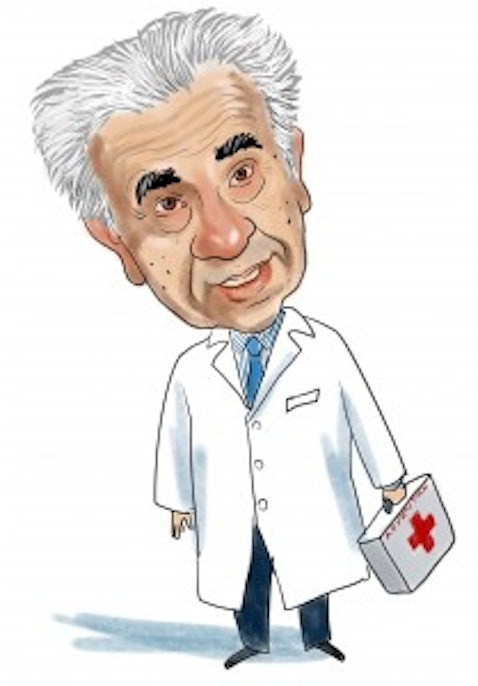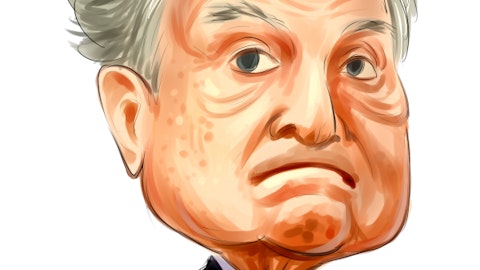Editor’s Note: Related tickers: Herbalife Ltd. (NYSE:HLF), Deutsche Bank AG (NYSE:DB), J.C. Penney Company, Inc. (NYSE:JCP), Yahoo! Inc. (NASDAQ:YHOO), Starbucks Corporation (NASDAQ:SBUX), Hewlett-Packard Company (NYSE:HPQ), Goldman Sachs Group, Inc. (NYSE:GS)

Herbalife Ltd. (NYSE:HLF), battling a billionaire investor’s bet that its stock will tank, is expected to reassure shareholders at the company’s annual meeting Thursday that the Los Angeles nutritional products maker is a strong, healthy, legitimate operation. The meeting at the Beverly Hilton comes amid lingering questions about Herbalife Ltd. (NYSE:HLF)’s future. For several months, two activist investors have put the company’s core operation at issue. Bill Ackman has bet $1 billion that the company is a pyramid scheme that will fail, and Carl Icahn bought 15% of Herbalife Ltd. (NYSE:HLF)’s stock, wagering that its business is legally sound and will withstand Ackman’s attack. This month, two more hurdles were thrown in the company’s way.
Steinhardt’s Judaica May Bring $11 Million at Sotheby’s (Bloomberg)
The collection of Judaica assembled over the past three decade by philanthropist and former hedge-fund manager Michael Steinhardt and his wife, Judy, is heading to the auction block next week in New York. “I am not trying to get rich from the sale,” said Steinhardt, 72, in a telephone interview. “I keep getting second thoughts. Why am I doing this? The truth is I’ve collected in three or four areas, at least. The Judaica collection was in my office and no one in my family was particularly interested in it. It was isolated from the rest of my life.”
J.C. Penney, Yahoo are Friday’s stocks to watch (Marketwatch)
J.C. Penney Company, Inc. (NYSE:JCP) shares are likely to continue attracting attention on Friday after hedge fund manager George Soros disclosed a significant stake in the retailer. As of April 15, Soros owned 17,386,361 shares, equivalent to a 7.91% stake, according to a regulatory filing. Earlier this month, J.C. Penney Company, Inc. (NYSE:JCP)’s board fired Chief Executive Ron Johnson, recruited from Apple Inc. by Bill Ackman in 2011, and brought back former CEO Myron “Mike” Ullman. After Thursday’s closing bell, Yahoo! Inc. (NASDAQ:YHOO) said Fred Amoroso resigned as chairman of the board and won’t seek re-election to the board at the shareholders meeting on June 25. The digital media company has named Maynard Webb interim chairman. Amazon.com Inc. late Thursday reported its first-quarter profit fell to 18 cents a share from 28 cents a share a year earlier but it still managed to beat Wall Street’s estimate on the back of strong sales. Starbucks Corporation (NASDAQ:SBUX) late Thursday said its fiscal second-quarter profit rose sharply thanks to robust sales growth in Asia and the Americas. The coffee retailer also raised its 2013 earnings outlook to a range of $2.12 to $2.18 a share from $2.06 to $2.15 a share.
Hedge fund Mariner navigates turbulent markets (Risk)
Faced with paltry bond yields and the risk of severe losses when interest rates inevitably rise, large institutional investors are stepping up their search for alternative sources of diversification. Mariner Investment Group, a $10 billion multi-strategy hedge fund manager, could be one of the main beneficiaries. While equities are enjoying a bull run, many of the big pension plans Mariner serves are fretting over the fate of their fixed income investments. “Pension funds face a real challenge,” says Bracebridge Young (pictured), Mariner’s CEO. “They need to maintain a relatively high allocation to equities to have any chance of meeting their return targets but none of them really like their fixed income exposure. They’re concerned about the duration of their bond portfolios and are looking for other ways to diversify their equity risk.”
PAAMCo. Seeks Assets, Managers In Asia (Finalternatives)
Fund of hedge funds Pacific Alternative Asset Management Co. is looking across its namesake ocean for new investors and new investments. Irvine, Calif.-based PAAMCo. hopes to diversify its investor base by luring pension funds and sovereign wealth funds in Asia, David Walter, a Singapore-based director for the firm, told Bloomberg News. Currently, U.S. clients account for 85% of PAAMCo.’s assets. “Asian investors are becoming more sophisticated and open to alternative investments,” Walter said. “There is now great potential to expand our relationships in the region.” “As investors get more sophisticated, they are increasingly going directly into large global hedge funds,” he added. “That’s where we see interest—is working with them in building customized portfolios of emerging managers to complement their existing holdings.”
Hedge Fund Pine River Capital’s High-Yield Picks (MarketWatch)
We maintain a database of 13F filings from hedge funds and other notable investors for a variety of purposes. For one, this information is useful in developing investing strategies; we have found, for example, that the most popular small-cap stocks among hedge funds generate an average excess return of 18 percentage points per year. …The fund’s largest holding at the end of December was its nearly 24 million shares of Annaly Capital Management NLY -0.06% . Annaly — like most of the high yielders we’ll be discussing here — is a real-estate investment trust. Such companies are required to distribute a large share of taxable income to shareholders in order to preserve their favorable tax treatment, and this often results in high yields. In the case of Annaly, this yield is over 10%.
A Billion-Dollar Misunderstanding (in Gold) (USNews)
There are small misunderstandings, like the one chronicled by Robert Grover in his cult book, “One Hundred Dollar Misunderstanding”. Then there are really big ones. The miscalculation by hedge fund gurus John Paulson and David Einhorn relating to the price of gold falls into the latter category. According to an article in Forbes, Paulson had a paper loss of around $1.4 billion on his gold investment this year, although he still has a gain since he created the gold share class for his hedge fund in 2009 when gold was selling at $950 an ounce. David Einhorn, who runs hedge funds (including a dedicated gold fund) at Greenlight Capital Management, also bet heavily on gold. According to Reuters, Einhorn’s investment in gold was recently listed as its third largest position in its main fund.
Hedge Fund Seeks Up To US$8 Billion From Deutsche Bank (Finalternatives)
A US$8 billion dispute between a hedge fund manager and Deutsche Bank AG (NYSE:DB) has made its way to the courts. Sebastian Holdings and Deutsche Bank are set to duke it out in a London courtroom over the next 12 weeks, the latter seeking payment of a US$250 million margin call, and the former demanding as much as US$8 billion in damages. Sebastian, led by Norwegian billionaire Alexander Vik, suffered “very significant” losses on options trades made by trader Klaus Said when Deutsche Bank AG (NYSE:DB), Sebastian’s prime broker, demanded US$530 million in collateral and, when it didn’t receive it, began liquidating the hedge fund’s positions. The latter, Sebastian said, cost it some potentially profitable positions, leading to losses and lost profits of US$2.5 billion.
CBOE dark for much of day due to software glitch (Reuters)
A software glitch shut down the Chicago Board Options Exchange for half the day on Thursday, preventing trading in options on two of the U.S. stock market’s most closely watched indexes and delivering the latest blow to confidence in the way U.S. financial markets operate. …The contracts are used by institutional and retail investors to bet on and hedge against swings in the overall U.S. stock market. “This is a big damage to the options industry because the SPX is such a significant product,” said J.J. Kinahan, chief strategist for TD Ameritrade, speaking at an options industry conference in Las Vegas attended by CBOE’s Brodsky and hundreds of other market participants. CBOE’s shutdown was the talk of the meeting.
No, HP Will Not Dance Its Way to a Corporate Turnaround (AllThingsD)
From the department of things you can’t make up, and so must leave to someone else to make up for you, here’s the most bizarre denial statement ever probably ever issued by the corporate public relations department at technology giant Hewlett-Packard Company (NYSE:HPQ). …Penned by Cheryl Strauss Einhorn, a freelance contributor to CNNMoney who also happens to be the wife of hedge fund manager David Einhorn, the story portrayed HP as a “lumbering tech giant that desperately needs new ideas.” It went on to detail how Von Hansen, a general manager for “future technologies,” based at HP’s campus in Boise, Idaho had since 2008 been working on a quarterly basis with The Trey McIntyre Project a local dance troupe. Its mission at Hewlett-Packard Company (NYSE:HPQ), according to a quote by Hansen in the story: “… Pull our staff out of the same way we do things so that we can better design solutions and solve problems.”
Aurelius, Alyeska Inspire Next Stage of Litigation Finance (InstitutionalInvestorsAlpha)
The biggest leveraged buyout in U.S. history was a “spectacular failure,” according to one New York hedge fund. The $43 billion deal, inked in 2007, was “hemorrhaging cash” within a year. It was also showing signs of an “untenable capital structure,” as company directors began to green-light loans worth billions of dollars from a subsidiary to the parent company in what the hedge fund calls a “continuing fraud” consisting of “classic fraudulent transfers.” Yet the hedge fund making each of these accusations, Aurelius Capital Management, went on to green-light investments of its own in the company, Dallas-based Energy Future Holdings (formerly TXU Corp.), becoming a creditor in January 2011. All of this can be seen in the fund’s lawsuit filed against the company last month. The concept of a hedge…
KKR Profit Drops (Finalternatives)
Kohlberg Kravis Roberts’ first-quarter earnings took a hit as its funds trailed the broader markets. The New York-based private equity giant said that economic net income fell 10.9% in the first quarter to $647.7 million. Under generally-accepted accounting principles, KKR’s profit actually rose by $3 million year-on-year to $193.4 million. KKR’s private-equity portfolio gained 5.9% on the quarter—better than most hedge funds, but a far cry from the more than 10% the Standard & Poor’s 500 Index advanced by during the year’s first three months. Assets under management rose almost 4% to $78.3 billion.
Millionaires Clash Over Socialite’s Child Support Claims (NYTimes)
As an accomplished mountaineer who has scaled many of the world’s highest peaks, including Mount Everest, Annabelle Bond has found herself in some dicey situations. Now she finds herself in a very different sort of predicament — a nasty legal fight between a former lover and her current one. Her boyfriend, Andrew Cader, a former Goldman Sachs Group, Inc. (NYSE:GS) executive and part owner of the Tampa Bay Rays baseball franchise, is accused of conspiring with Ms. Bond to hide her true financial condition so that she could secure more than $50,000 a month in child support payments last December from the Wall Street financier Warren G. Lichtenstein, who has a 5-year-old daughter with the British socialite.
How Many HFT Firms Actually Use Twitter to Trade? (BusinessWeek)
Tuesday’s fake tweet from the Associated Press’s hacked Twitter account, reporting explosions at the White House that injured President Obama, has sparked renewed criticism of high frequency trading, specifically how some computer traders use social media as an input into their trading strategies. Though it’ll be months before we know exactly what happened, the consensus is that a handful of trading algorithms responded to the fake tweet by selling a broad range of stocks, bonds, and commodities. As message traffic spiked and prices started declining, HFT firms started backing out of the market, just as they did during the May 2010 Flash Crash. As a result, liquidity dried up, as you can see here in this chart from Nanex. Since there were suddenly relatively few buy orders to match against all those sell orders flooding the market, the dip picked up speed.




